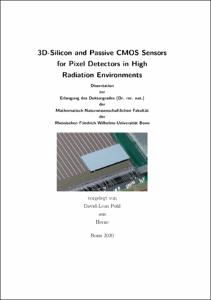Pohl, David-Leon: 3D-Silicon and Passive CMOS Sensors for Pixel Detectors in High Radiation Environments. - Bonn, 2020. - Dissertation, Rheinische Friedrich-Wilhelms-Universität Bonn.
Online-Ausgabe in bonndoc: https://nbn-resolving.org/urn:nbn:de:hbz:5-60007
Online-Ausgabe in bonndoc: https://nbn-resolving.org/urn:nbn:de:hbz:5-60007
@phdthesis{handle:20.500.11811/8743,
urn: https://nbn-resolving.org/urn:nbn:de:hbz:5-60007,
author = {{David-Leon Pohl}},
title = {3D-Silicon and Passive CMOS Sensors for Pixel Detectors in High Radiation Environments},
school = {Rheinische Friedrich-Wilhelms-Universität Bonn},
year = 2020,
month = oct,
note = {The future upgrade of the Large Hadron Collider to the High-Luminosity LHC demands new pixel detectors that can operate in environments with exceptionally high radiation. This requires investigations into new radiation-tolerant sensor technologies and readout electronics, and the advancement of radiation-damage models. In this work, planar- and 3D-silicon sensors from the latest upgrade of the ATLAS pixel detector~(IBL) and novel passive CMOS sensors are characterized after high levels of irradiation. New measurement techniques for the readout chip (ATLAS FE-I4) enabled precise charge-collection efficiency studies with highly segmented silicon sensors and the extraction of radiation-damage model parameters. A dedicated simulation, based on a model with just 2 parameters, successfully describes the dependence of charge collection on sensor voltage up to a fluence of 5e15 neq/cm² NIEL. The life-time of charge-carriers in silicon at 5e15 neq/cm² NIEL is determined to be (0.75 ± 0.08) ns. At 7e15 neq/cm², the charge-collection efficiency is about 50 % for 3D- and 250 um planar-silicon sensor designs. The 3D-silicon sensors demonstrate a much lower power consumption (~15 %), which is an important advantage for their potential usage in the innermost layer of the future pixel detector. For the outer pixel layer, which has relaxed requirements for radiation-tolerance (1e15 neq/cm²), a novel prototype of a planar silicon sensor is characterized. Since the sensor implantations are produced using a 150 nm CMOS process from LFoundry, they are termed 'passive CMOS' sensors. A detailed study with respect to crucial sensor parameters, such as bulk resistivity (> 2 kOhm-cm), capacitance (105 fF), and detection efficiency (99 %) reveals similar performance to current ATLAS planar-silicon sensors. Additionally, resistor biasing of pixels, a feature available in the CMOS process, enhances the detection efficiency by approximately 1 %. Driven by these promising results, the option to use passive CMOS sensors for the future ATLAS pixel detector is actively pursued.},
url = {https://hdl.handle.net/20.500.11811/8743}
}
urn: https://nbn-resolving.org/urn:nbn:de:hbz:5-60007,
author = {{David-Leon Pohl}},
title = {3D-Silicon and Passive CMOS Sensors for Pixel Detectors in High Radiation Environments},
school = {Rheinische Friedrich-Wilhelms-Universität Bonn},
year = 2020,
month = oct,
note = {The future upgrade of the Large Hadron Collider to the High-Luminosity LHC demands new pixel detectors that can operate in environments with exceptionally high radiation. This requires investigations into new radiation-tolerant sensor technologies and readout electronics, and the advancement of radiation-damage models. In this work, planar- and 3D-silicon sensors from the latest upgrade of the ATLAS pixel detector~(IBL) and novel passive CMOS sensors are characterized after high levels of irradiation. New measurement techniques for the readout chip (ATLAS FE-I4) enabled precise charge-collection efficiency studies with highly segmented silicon sensors and the extraction of radiation-damage model parameters. A dedicated simulation, based on a model with just 2 parameters, successfully describes the dependence of charge collection on sensor voltage up to a fluence of 5e15 neq/cm² NIEL. The life-time of charge-carriers in silicon at 5e15 neq/cm² NIEL is determined to be (0.75 ± 0.08) ns. At 7e15 neq/cm², the charge-collection efficiency is about 50 % for 3D- and 250 um planar-silicon sensor designs. The 3D-silicon sensors demonstrate a much lower power consumption (~15 %), which is an important advantage for their potential usage in the innermost layer of the future pixel detector. For the outer pixel layer, which has relaxed requirements for radiation-tolerance (1e15 neq/cm²), a novel prototype of a planar silicon sensor is characterized. Since the sensor implantations are produced using a 150 nm CMOS process from LFoundry, they are termed 'passive CMOS' sensors. A detailed study with respect to crucial sensor parameters, such as bulk resistivity (> 2 kOhm-cm), capacitance (105 fF), and detection efficiency (99 %) reveals similar performance to current ATLAS planar-silicon sensors. Additionally, resistor biasing of pixels, a feature available in the CMOS process, enhances the detection efficiency by approximately 1 %. Driven by these promising results, the option to use passive CMOS sensors for the future ATLAS pixel detector is actively pursued.},
url = {https://hdl.handle.net/20.500.11811/8743}
}






